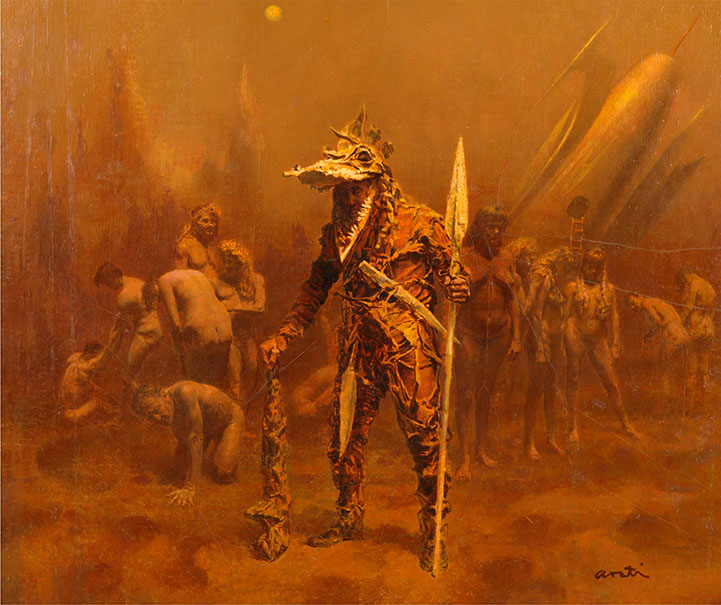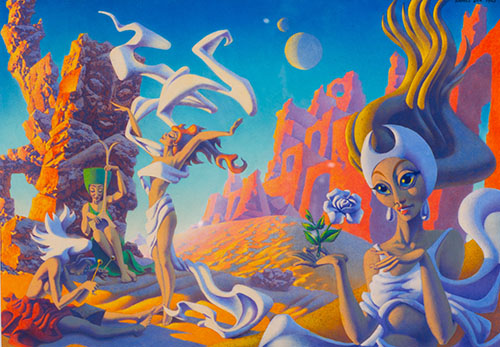
One of the things that I do each month at Apex Magazine is find cover art. It’s a task I picked up after stepping into the role of managing editor, and one that I that I absolutely adore. I could browse artwork for hours and still find the search fascinating. And if you find me at a con and want me to engage (rather than sharing an awkward, mumbling pseudo-conversation), ask me about Apex’s covers. I’ll open up and have you looking for an escape after an hour of discussion.
I grew up surrounded by artwork, paintings on every wall of our house, tons of trips to museums, and discussing art with my father, who has a degree in art and who’s own father was a painter and art professor. Art is in my blood and my upbringing, making the opportunity to speak with Stephen Korshak, owner of the Korshak Collection, something I jumped to do.
Stephen grew up in a home lush with artwork, most of which were the sci-fi illustrations for novels his father published through Shasta Publishing. Though he always loved the artwork of his father’s novels, he quickly realized that many did not see illustration art in the same light as they did fine art. This perception is slowly changing, with artists such as Norman Rockwell and Howard Pyle being considered fine artists as well as illustrators. To help even more people see and understand the beauty of illustration art, Stephen is taking his vast collection on tour, starting in Baltimore, MD in April and May, and making stops in New York, Connecticut, and Wisconsin throughout the rest of this year and into early 2018.
Before the collection went out for tour, Stephen was kind enough to answer some of my questions about his views on art, the collection, and the relationship between books and their covers.
APEX MAGAZINE: You grew up surrounded by artwork, from those hung on the walls of your childhood bedroom to the work your father used as cover art at his publishing house. How do you think this environment shaped your appreciation of cover illustration as well as art as a whole? Do you see a distinction between the two?
STEPHEN KORSHAK: As a young child growing up with great illustration art I first remember a sense of wonder, where I lost myself in fantasy worlds. As I grew older and read the literature that the art illustrated I learned how illustration and literature were intertwined with each other. And when I studied art history I learned that a false dichotomy had developed in the art field that perpetuated a belief that there was fine art and that there was illustration art and they rarely intersected. During the last decade, illustrators like Howard Pyle, N.C. Wyeth, and Maxfield Parrish were seen as great artists. I hope that when people see this exhibition, the illustrators in this exhibit will be seen as great artists as well.
AM: Looking at the Korshak Collection online, I can see you have a varied collection that includes many artists from many different countries as well as time periods. What drew you to the pieces in your collection? How are individual pieces selected for inclusion?
SK: When building any collection, it is important to note that what the collection excludes is just as important as what the collection contains. There is a difference between collecting and merely amassing items. Collecting is built around a theme, a set of related works where you are trying to say something and teach others. Amassing does not have a theme—it usually consists of whatever the collector likes.
The theme of our collection is “great illustrators and illustrations of great importance.” There are literally thousands of great illustrators that have worked in the field. We have chosen to include illustrators that we believe are among the greatest as well as some illustrators who we believe have made a significant impact in the field.
Finally, we have also striven for quality over quantity of artworks. Less is more, if you will.
AM: With a collection as large as yours and spanning as many years as yours does, you must be able to look at it and see trends and influences from specific time periods. What are some of the trends you’ve noticed in your collection, and how do you think they reflect the time periods in which they were created?
SK: Just like everything else in life, illustrators and the public at large are influenced by trends. One or two illustrators usually tend to incite these trends. In the United States in the 1920s, Frank R. Paul was the Father of Science Fiction Art. He was the first one to expose the public to a visual sense of wonder that captured the mood of early science fiction literature. Many times his scenes involved some sort of peril from aliens, natural disasters, or science fiction machines. During this same time, J. Allen St John added to the genre by using heroic fantasy as one of his themes. In the 1930s Maragret Brundage changed the look of science fiction, horror, and fantasy by replacing robots and aliens with sexual scenes. In the 1940s Hannes Bok used a very stylized approach, while Virgil Finlay drew beautiful women, ghoulish faces, flames, and bubbles. Skip to the 1960s and illustrators like Richard Power added an abstract, almost a Salvador Dali aesthetic to the field. At the same time, Frank Frazetta employed a powerful and explosive action feel to his work. All of these illustrators have influenced other illustrators working in the field, and they will continue to influence future illustrators in the field. Trends come and go, greatness lasts forever.
AM: Many of the pieces in your collection have been featured as the covers for timeless novels such Edgar Rice Burroughs’s Tarzan series and classic pulp magazines like Amazing Stories and Weird Tales. I know from my experience that cover art is something that brings out a lot of different points of view with opinions ranging from “Don’t judge a book by its cover” to those, like myself, who believe a great cover can go a long way toward helping a book be successful. What do you think? How important is cover art for a book or magazine?
SK: Authors, artists, and collectors are inextricably interrelated with each other. An author’s work comes to life through an artist’s illustration of the written work. An artist’s illustration work, in turn, is perpetuated through a collector’s collection. When properly done, a collection reintroduces artists to a new generation of collectors, who are again obligated to act as custodians for another generation so that the cycle continues ad infinitum. Those unfortunate souls who lock up artwork in storage vaults in Switzerland or in closets in their home fail the true tests of a collector.
As Einstein said, “Science without religion is lame, religion without science is blind.” Authors, artists, and collectors all need each other. An author’s words are blind without the illustration artist. Artists’ reputations are lost and become empty without collectors researching and exhibiting their work.
AM: You are currently exhibiting the collection. Can you tell us a little bit about this? Where can people go to see your collection and what should they expect?
SK: Collecting is a journey that one travels and in the process, discovers things about themselves and about the field. Part of the joy of collecting, for me, is being able to share the collection with others and to help them learn something about themselves and the field as they view the collection.
The collection is going primarily on an east coast tour this year appearing first April 10-May 16 at the University of Maryland, Baltimore Albin O. Kuhn Library & Gallery; June 7-August 19, 2017 at the Society of Illustrators, New York, NY; September 23-October 29, 2017 at the Stamford Museum, Samford, CT; finally it goes to the midwest in November 20-February 4, 2018 at the Chazen Museum at the University of Wisconsin-Madison, Madison, Wis. Future exhibitions will take place in the Midwest, the mountain states, the South, and the West coast.
AM: What do you hope that people who view your collection—either online through one of your art history books or in person at an exhibit—will take away from the experience? What do you want people to know about science fiction and fantasy art and illustrations?
SK: I hope the people who see this exhibit get a sense of amazement of worlds that were, worlds that might have been, and worlds that can never be. It is this sense of amazement or wonder that motivates us all—scientists, musicians, school teachers, politicians, etc. It adds a purpose and richness to our lives.
In a general sense, all of art’s purpose is to engender that sense of wonder—in a specific sense, science fiction and fantasy artwork try to visualize an author’s text to convey that sense to a potential reader and then to motivate that person to buy that book or magazine. The fact that the illustrator is trying to sell you something does not make it less of an art.
For me, I will be happy if the public that views our collection leaves the show and learns something new about themselves and the field, and is moved by what they saw. So much that if some are moved enough to become new collectors, in this way the field flourishes and the cycle of author, artist, and collector continues on.
AM: Thank you, Stephen, for sharing your knowledge and obvious passion for art.
I’m hoping to get the chance to see the collection in person before it leaves Baltimore. If you are interested in seeing the Korshak collection in person, be sure to check out the dates and locations of upcoming tour stops on their website.












